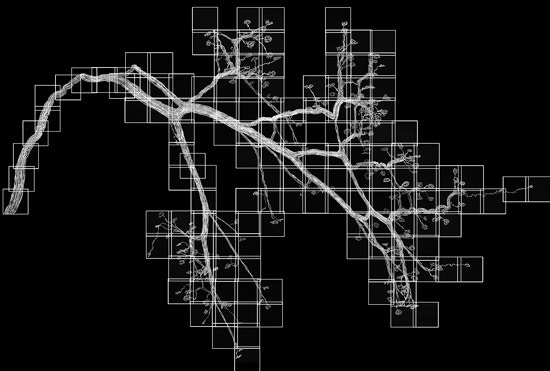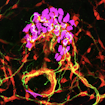
J.W. Lichtman
Precise measures:Research on neural circuits in autism is generally limited to circuits with well-defined functional properties.
Much of the recent advances in autism research have been on the genetic and behavioral levels of dysfunction present in the disorder. Comparatively little is known about altered function in the underlying neural circuitry. Aiming to generate discussion on the best avenues to pursue in order to better understand the circuitry in autism, SFARI held a one-day workshop on 17 May.
SFARI director Gerald Fischbach introduced the workshop by noting that specific physiological assays will be needed to assess mouse models that are being developed based on recent genetic findings.
Attempts to link a behavioral disorder to dysfunction in neural circuitry will have to consider a range of physiological levels, from individual synapses and neurons up to the level of cortical columns or large, inter-regional networks of the brain. Tom Jessell of Columbia University pointed out that about 100 genes have so far been linked to autism. The fact that some of these genes encode synaptic proteins such as neurexin and neuroligin suggests that autism is at least partially a disorder of synaptic function.
What’s unclear is how microscopic changes in the expression of proteins cause macroscopic effects on how information is processed in the brain. For example, altering genes that have a widespread role in the nervous system can lead to specific problems in an organism’s behavior. Tony Movshon of New York University suggested that researchers should consider circuits on multiple levels from a computational perspective. Quantitative characterization of how synaptic inputs are transformed into spiking output could help explain how small changes in a few synapses give rise to larger phenomena of neural networks.
Discussions throughout the workshop revolved around three key questions. First, what criteria should be used to select mouse models for physiological studies? Second, which specific neural circuits should be probed for dysfunction in these animal models? Third, which physiological assays are robust enough to be able to detect any functional abnormalities in the circuitry?
Animal models:
Given that autism encompasses a spectrum of disorders that don’t appear to all be linked to a single genetic defect, selecting mouse models for neurophysiological evaluation is no easy task.
One approach would be to select the mouse lines based on a behavioral criterion, much as the disease is diagnosed in humans. But what do the behavioral features associated with autism look like in mice? For example, would the mice show repetitive behaviors or impairments in social interaction?
David Ferster of Northwestern University noted that for a behavioral screen to be useful, it must be easily quantifiable and have a small variance, so that it can detect deviations from normal behavior. Researchers adhere to a few basic behavioral assays — such as fear conditioning and the Morris water maze — for precisely this reason, but it’s unclear whether subtler aspects of autism-related behavior can be similarly assessed.
A second approach would involve selecting autism-related genes that are directly involved in regulation of proteins within the nervous system, and to create mouse lines based on those genes. However, genes not directly linked to synaptic function also lead to the behavioral traits seen in individuals with autism. It is unclear whether the observed behavioral dysfunction is a direct result of these altered genes, or of subsequent compensatory mechanisms during development. Regardless of differences in underlying genotype, there is a common pathway that leads towards similar behavioral phenotypes.
The workshop participants agreed that screening and assaying a large number of mouse lines is impractical, and that it would be best to select a small number of candidate mouse models for directed physiological research. Many of the participants suggested starting with known genetic candidates — such as the well-documented deletions on chromosome 16. Participants also agreed that multiple labs should investigate separate neural circuits and systems in the same mouse models, aiming to build a more comprehensive picture of a given gene’s effect on development of the neural circuitry.
Neural circuits:
Once candidate mouse models have been selected, it is important to choose neural circuits to probe for alterations in their functional properties. In order to detect dysfunction, whether in behavior or in functional neurophysiology, what’s required are precise and reliable measures of how the system normally operates. This necessarily restricts research on autism to neural circuits that have some well-defined functional properties.
Peter Jonas at the Freiburg Institute for Advanced Studies presented research on one specific type of interneuron — a neuron that forms only local projections to nearby neurons — found in the hippocampus. These basket cells release neurotransmitters that inhibit the firing of the neurons to which they project, and they specialize in providing inhibition that operates on a rapid and precise timescale.
Influx of calcium into an axon terminal triggers a signaling cascade that eventually leads to neurotransmitter release from the synapse. Jonas showed that there is very tight coupling between calcium ion sensors and channels, and that only a few calcium channels need to be activated to trigger neurotransmitter release. Arrival of an action potential at an axon terminal leads to calcium influx, which in turn is quickly translated into neurotransmitter release, allowing for rapid and temporally precise signaling across the synapse. Given its synaptic specialization, Jonas suggested that this might be an interesting circuit to probe for altered synaptic function in mouse models of autism.
Wade Regehr of Harvard University presented behavioral data from knockout mice lacking MUNC13-3, which encodes a pre-synaptic protein. The protein, which is normally expressed in cerebellar granule cells, is thought to control the probability of neurotransmitter being released when an action potential arrives at the axon terminal. The knockout mice show a behavioral deficit in a motor-learning task, linking a specific gene to a behavioral outcome. However, Regehr’s physiology studies highlight the difficulty in relating behavior to specific changes in the cortical circuit. A 2001 study shows changes at the synapse that granule cells make onto neurons called Purkinje cells1, but Regehr’s work shows that the behavioral changes could be reflective of changes at a different synapse, that of granule cells onto Golgi cells. The implication is that using a single restricted assay might not reveal the locus of alteration in the neural circuitry.
Dan Feldman at the University of California, Berkeley, pointed out that most behavioral research on autism focuses on higher cognitive processing — such as social interaction and facial recognition — whereas the best described neural circuits are more low-level and involve more purely sensory or motor areas.
Feldman cited a 2008 study showing that individuals with autism demonstrate less sensory adaptation to tactile stimuli because of a presumed lack of inhibition2. Studies of this kind, focusing on more basic sensory or motor processing impairments in autism, would help decide where to begin looking for physiological phenotypes in those cortical circuits.
Changes in the level of inhibition, or disruption in the balance between excitation and inhibition, are often implicated in many mental disorders. Feldman presented results from rodent whisker-barrel cortex showing how a convergence of excitatory and inhibitory inputs in the local circuit gives rise to specific functional properties. Among these is the fact that the neurons fire reliable and temporally-precise action potentials in response to a stimulus and, across the population of neurons, only a few are active in response to a given stimulus.
Ferster also presented data on how the balance of excitation and inhibition shapes the functional properties of local circuits. He showed evidence both from cat primary visual cortex and computational models that strong inhibition in a recurrent network produces neurons that are selective for the size of a stimulus in their receptive field, a phenomenon known as surround suppression. Ferster’s and Feldman’s studies both provide quantitative measures of the local circuitry that could be examined for altered function in mouse models.
Finally, large-scale changes in neural network activity such as oscillations or synchronization have been shown to be involved in some mental disorders. This suggests that some changes in the neural circuitry in individuals with autism might not be visible at the level of individual synapse or cells, but only at the scale of the larger network.
Angus Silver at University College London presented physiology and modeling data from Golgi cells in the cerebellum, which are inhibitory interneurons that are electrically coupled to each other through gap junctions. Silver showed that these cells can synchronize or desynchronize their firing depending on the synaptic inputs they receive, and that both of these high level network properties depend on gap-junction coupling. This provides at least one example in which slight changes in synaptic properties can lead to global changes in the network behavior.
Physiological assays:
In order to screen several different neural circuits in a handful of mouse models of autism, the assays for physiological function must be carefully selected. On the one hand, the assays must be fairly straightforward to allow for multiple measurements in different regions of interest. On the other hand, they must be precise and robust enough to allow for quantitative changes in the physiology to be detected. Fischbach expressed the concern that a candidate gene might be discarded simply because of poor choices of physiological assay.
The workshop participants agreed on two kinds of assay as appropriate for initial investigation of the neural circuitry in autism. The first level is on the scale of individual neurons and focuses on such aspects as the number of synapses, basic measures of synaptic function and intrinsic excitability. These assays have the advantage of being relatively straightforward approaches that would narrow down the list of candidate circuits for further investigation.
The second level of assay discussed is for larger-scale networks of neurons. Researchers can make measurements in vivo by recording local field potential or multifocal EEG activity, and characterizing the properties of oscillation and synchronization among neuronal populations. These recording methods might reveal neural correlates of more cognitive phenomena that might be missed by looking at synaptic mechanisms.
In summary, participants agreed that autism research should focus on multiple neural systems at multiple physiological levels in a handful of promising mouse models. Inevitably, the lines of research will focus on the circuits with the best functional characterization. Human behavioral studies on more basic sensory and motor computations can also help decide which physiological aspects of those circuits should be probed. Basic, rigorous measurements of physiological properties such as synaptic function and network synchronization seem to be an appropriate first foray into studying the neural circuitry underlying autism.
The final discussion centered on how best to encourage these avenues of research. Systems neuroscience labs tend to be small and often don’t have large numbers of researchers to study disease-related projects. There may also be concern that the research strays too far from basic science. One possible solution would be to award grants that fund both the disease studies and the lab’s own basic research. This has the added benefit of furthering understanding of how the circuits normally function, and may lead to the development of new assays. Many young researchers are also attracted to biomedical research because of a personal connection to specific disorders.


